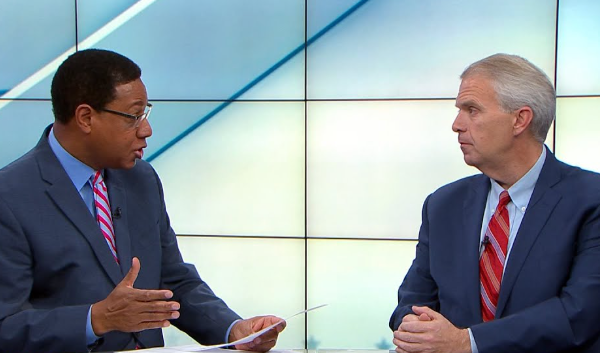For WTVA meteorologist Matt Laubhan doing his live weathercast from his house for the first time wasn’t easy.
“Last night was my first live shot I ran all by myself. If it could break it broke. I couldn’t get in on the VPN, I couldn’t get this to work. It was just, it was something,” Laubhan said.
But, he did get on the air and he now has what he hopes will be a better plan.
“So, I came up with the idea to take a live truck, park it in my driveway, so that it could be a semi-permanent fixture,” Laubhan said. “I’d never run an ENG truck prior to this afternoon when my chief engineer walked me through everything to do it and I took some videos.”
Here’s how Laubhan is making the rest of the process work.
Using a virtual set. “We discussed the chroma key at home. That’s still on the table. But basically, we have an augmented reality set, I guess is the best way to put it.” Laubhan says their graphic system has also helped make this all possible. “We’re blessed that we have WSI’s Max Reality that corporate invested in that a couple of years ago.
Relying on a Virtual Private Network (VPN) and an iPad to update and manage graphics. “It’s a labor-intensive process when you’re sitting in front of a high-end work station. It becomes extremely difficult when you’re trying to do it through an iPad over a limited internet connection VPN. I am hopeful that my end should be ready by Monday to where it is really doable at that point.”
Strong engineering support. “The engineering staff is running around non-stop, working all kinds of crazy hours to make this work to where all parts of our newscast are going to be from home pretty soon.”
Laubhan says meteorologists may be ideally suited for this new paradigm, but some may need to remember that it’s OK for the weathercast to be less than perfect.
“People at home aren’t living normally. So, you have to find a way to set an example. You have to still give people at home what they expect. Not every station has, in fact, most stations don’t have augmented virtual reality, so what we do is off the table. So, go to Joann Fabric before you can’t get in and buy a giant green sheet and prepare to do chroma key weather from home if you can. So much of it is a discussion, is an effort with the engineering staff to make sure you can remotely get in and do what it is you do every day. And then, just be willing to accept that it’s not going to be what you did three weeks ago. The best you can do is good enough.”
COVID-19 has already moved much of the reporting process and even newscast production out of the newsroom. What we hear at NewsLab is that at least two other stations — WDBJ in Roanoke, VA and WKYT in Lexington, KY are already doing weather remotely as well, and there may be more stations considering the move.
“Everything about this outbreak has been exponential, how it ramps up. You might not have until the end of next week to get things done, so spend some time this weekend talking about it. Come up with a plan. Take the time this weekend to talk with the decision-makers, so that by Monday you have the wheels already rolling because by Friday it might be too late. You have to ask the question, is it possible that the president could issue some kind of a national, we all have to stay in directive by that point? So, it’s very possible that if you want your viewers to have the information that they have to have, that a plan has to already be moving and we need to be testing it by the first of next week.”
Finally, Laubhan says doing the weather from home may require a few more adjustments for some.
“I had to call the sitter and make sure the kids were in bed before I came home and try to keep the dog on the inside, so he didn’t knock over the camera.”








